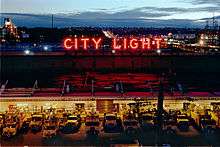Seattle City Light
|
| |
| Agency overview | |
|---|---|
| Formed | 1905: The first municipally owned hydro facility, Cedar Falls, begins generating power for Seattle |
| Type | Electric utility |
| Jurisdiction | City of Seattle and some outlying communities |
| Headquarters | Municipal Tower, 700 Fifth Avenue, Seattle, Washington, United States |
| Employees | 1,872 |
| Agency executive |
|
| Website | http://www.seattle.gov/light |

Seattle City Light is the public utility providing electrical power to Seattle, Washington, US, and parts of its metropolitan area, including all of Shoreline and Lake Forest Park and parts of unincorporated King County, Burien, Normandy Park, Seatac, Renton, and Tukwila.[2] Seattle City Light is the 10th largest public utility in the United States and the first municipal utility in the US to own and operate a hydroelectric facility.
Seattle City Light is a department of the City of Seattle and is governed by Seattle City Council. Currently, Seattle City Council Member Kshama Sawant heads the committee that oversees Seattle City Light.
Overview
The approximately 776,336 residents (422,810 metered customers) served by Seattle City Light use about 9,157,494 megawatt-hours annually.[3] Seattle City Light was the first electric utility in the nation to become greenhouse gas neutral (2005)[4] and has the longest running energy conservation program in the country. The utility owns a large portion of its generation, which is predominately hydro, so is able to offer some of the country's lowest rates to its customers (of utilities in urban areas).[5] Seattle City Light's customer breakdown shows 381,419 residential customers who consumed 2,914,563 megawatt-hours of electricity in 2015 and 41,391 non-residential customers that consumed 6,242,931 megawatt-hours.[6]
History

Public responsibility for electrical energy in Seattle dates to 1890 with creation of the Department of Lighting and Water Works. In 1902, Seattle voters passed a bond issue to develop hydroelectric power on the Cedar River (Washington) under the administration of the Water Department. Electricity from this development began to serve Seattle in 1905. A City Charter amendment in 1910 created the Lighting Department. Under the leadership of Superintendent James D. Ross, the department developed the Skagit River Hydroelectric Project, which began supplying power in 1924. Both public and private power were supplied to Seattle until 1951 when the City purchased the private electrical power supply operations, making the Lighting Department the sole supplier. The Boundary Project in northern Washington began operation in 1967 and currently supplies over half of City Light's power generation. Approximately ten percent of City Light's income comes from the sale of surplus energy to customers in the Northwest and Southwest. The current name of the agency was adopted in 1978 when the Department was reorganized.[7]
In 2014 City Light completed the installation of 41,000 LED street lights along residential streets. Installation of LED streetlights on arterial streets started in 2015 and is expected to be complete by the end of 2018.[8]
Seattle's electricity supply
The most recent official fuel mix statistics by the state of Washington for Seattle City Light show approximately 89.6% hydroelectric, 4.3% nuclear, 3.6% wind, 0.9% coal, 0.9% other (including biomass, natural gas, petroleum and waste), and 0.7% landfill gases.[9] City Light's portfolio of energy sources includes electricity purchased through long-term contracts with the Bonneville Power Administration (BPA). The remaining power comes from a mixture of sources.
Owned facilities
The utility owns and operates a total of seven hydro facilities:
- The Skagit River Hydroelectric Project, a series of three hydroelectric dams (Gorge, Diablo, and Ross) on the Skagit River in northern Washington State. The project supplies approximately 25 percent of Seattle's electric power.
- The Boundary Dam on the Pend Oreille River in northeastern Washington State
- Cedar Falls Dam, about 35 miles southeast of Seattle
- South Fork of the Tolt
- Newhalem
Seattle City Light residential customers currently pay about 8 cents per kilowatt-hour of electricity. Seattle has the lowest residential and commercial electrical rates among comparably-sized cities in the United States.[10]
Scrubbing dispute
The utility's former CEO, Jorge Carrasco, got in a dispute with brand.com over search result "scrubbing".[11]
Notes
- ↑ "Seattle City Light". Retrieved March 22, 2016.
- ↑ Seattle City Light Rates Area Map, Seattle City Light. Accessed online 2009-10-07.
- ↑ Seattle City Light Annual Report, Seattle City Light (2015, based on internal evidence). Accessed online 2016-08-03.
- ↑ http://www.seattlepi.com/local/article/No-global-warming-at-City-Light-1187133.php
- ↑ http://www.seattle.gov/light/rates/docs/NUand25CitiesRateTable2014.pdf
- ↑ http://www.seattle.gov/light/pubs/annualrpt/2015/flipbook/index.html?page=1
- ↑ Shannon Lynch and Scott Cline, Guide to the Seattle City Light Department History File 1894-1972, Northwest Digital Archives (NWDA), 2004. Accessed online 2009-10-07.
- ↑ http://www.seattle.gov/light/streetlight/led/
- ↑ Fuel Mix: How Seattle City Light Electricity is Generated (information is for calendar year 2014), Seattle City Light. Accessed 2016-08-03.
- ↑ No rate changes at Seattle City Light for 2009, Seattle City Light news release, 2008-09-26. Accessed online 2009-10-07.
- ↑ "Seattle utility wants $17,500 refund after failure to scrub negative search results | Ars Technica". Ars Technica.
External links
- Seattle City Light website
- Seattle City Light's Facebook page
- Seattle City Light's Twitter account
- Guide to the Seattle City Light Department History Files 1894-1972
- Guide to the Seattle City Light Annual Reports 1910-2000